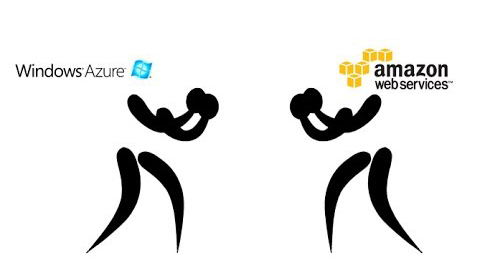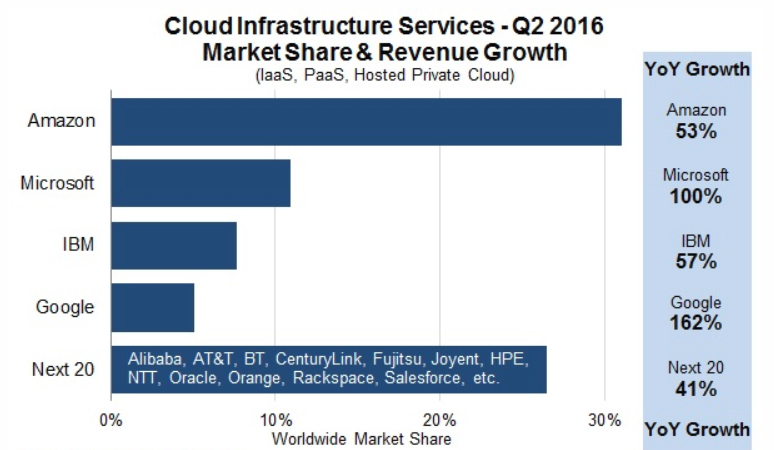When you talk about Microsoft and the way it completely dominated and monopolized the software sector for almost two decades, it’s not surprising that 2017 brings yet another battle for supremacy involving the software giant: Microsoft Azure vs Amazon Web Services.
This time, however, the story is a bit different. The Microsoft that dominated the software sector never really had any competition worth mentioning. Though there were a lot of competing products, they were easily muscled out by Microsoft’s OS-based monopoly. This time it’s not just a rival that Microsoft is facing, but a much bigger and heavier one. If this were a boxing match, Microsoft would be moving up at least two weight classes from where it’s used to fighting — and winning.
From undisputed champion to No. 1 contender
The saga of how an online bookstore came to be this formidable foe that Microsoft now faces is another story altogether. Though every previous battle has seen Microsoft as the defending champion, there’s no doubt this time around that Microsoft is merely the No. 1 contender. This is because as of the second quarter of 2016, AWS holds about a combined 31 percent market share of IaaS, PaaS, and hosted private clouds, according to a report by Synergy Research Group. Microsoft is way behind at about 9 percent, and Google’s cloud is at about 8 percent.

Nobody even seems to be acknowledging IBM’s cloud at 5 percent, and OpenStack is not even in the picture. But don’t let the way things stand deceive you into thinking that AWS is invincible, because the growth charts may be painting a different picture altogether. Based on the second quarter market shares of 2016, Google leads the year-over-year growth race at 162 percent followed by Microsoft at 100 percent. AWS’s growth rate, meanwhile, is in fourth place behind IBM at under 60 percent.

From online shopping to cloud supremacy
“The big 3,” as they are now being called, have distanced themselves from the rest of the market in such a way that the next 20 spots combined don’t equal AWS’s market share. We all know Microsoft’s determination to succeed is combined with the backing, muscle, and experience that has come from years of dominating the software sector. Let’s take a close look at the current champion and why exactly Microsoft finds itself in the runner-up spot by such a large margin.
One obvious reason is that as far as pure power goes, AWS has about 10 times the compute capacity of its 14 closest rivals. While those numbers sink in let me reiterate that this was once an online bookstore. While Microsoft was busy fighting a hundred different battles on different fronts including operating systems, phones, office productivity suites, and networking, an online shopping portal quickly understood that most startups have significantly low compute utilization and are often subject to periodicity. The rest, as they say, is history, and it brings us to our current cloud war.
New opponents = new strategies
Now, though Microsoft and Google are both gaining ground, AWS is going one step further and physically transferring data to the cloud in an effort to gather what little market share is still left. The old Microsoft would probably make sure that nothing else in the world would be compatible with their cloud except their own stuff, but this time around they don’t have that luxury. Compatibility seems to be the name of the game, and both AWS and Azure are going to great lengths to make sure that everything from Docker containers to Hadoop clusters are compatible with their cloud platforms.
Apart from cross compatibility, cloud computing is mostly about cutting costs, and while AWS rounds off charges to the hour, Microsoft is going one step further and rounding them off to the minute. This could also be one reason Microsoft is growing faster than AWS as far as cloud computing goes.

A new and improved Microsoft
They say that good champions need good challengers, and this challenger position seems to be bringing out the best in Microsoft. This is a Microsoft we like to see, and apart from going out of their way to repair their damaged image, they seem to be really trying to make people’s lives easier. Being in the second spot and fighting tooth and nail for each customer seems to be helping Microsoft realize its potential. The game plan looks like “pick holes in Amazon’s offerings and counter with something better.”
One example is that though you need to purchase storage separately with each instance from AWS, Azure instances come with a fixed amount of storage. Another example is that while AWS charges for support on an “as-needed basis,” Azure has a flat rate, and this really benefits users who need a lot of support.
Convenience vs. power
Another place where the two giants differentiate from each other is with regards to “ease of use.” Windows admins much prefer Azure as it doesn’t require any initial learning and is quite straightforward whether you want to migrate your entire datacenter to the cloud or setup a hybrid center. AWS seems to be a bit dismissive of the hybrid cloud and on-premises centers as is seen clearly in their efforts like project Snowball and Snowmobile. Though AWS does have an initial learning curve, like Microsoft’s old rival Linux, once you get the hang of it there’s a whole lot more you can do than you could ever do on a Microsoft platform.
So when it comes down to a choice between the two, AWS has size, power, and, some say, compatibility with open-source tools. Microsoft seems to be doing everything in its power to copy this and has been going out of its way to support the open-source community. Apart from being the No. 1 contributor to GitHub last year, they have also released a lot of their own code to the public as well.
One place where you just have to give it up to Microsoft is that Azure links well with most of the popular closed-source applications that are used in datacenters across the world. Add to that the attractive pricing, and Azure should be the obvious first choice for such centers. AWS, however, comes with the “tried and trusted” tag that a lot of enterprises prefer.
Cloudy skies ahead
This “cloud war” seems be bringing out the best in both companies in terms of technology and innovation, and this new Microsoft seems to be listening to its customers and finding ways to one-up its competition. Like we mentioned earlier, this only benefits end users and has given rise to a highly affordable and powerful alternative to expensive on-premises equipment. Both companies continue to push the envelope as far as services are concerned and both have added AI capabilities, deep learning and on-demand GPU processing as part of their arsenal.
Sometimes less is more
One place where Microsoft looks like it has an advantage is, surprisingly, in the simplicity of its offerings when compared to the wide range of features that AWS offers. For new users, less is often more, and the simpler approach from Microsoft tends to make Azure a more “manageable” platform. How things unfold is left to be seen. Meanwhile, we shouldn’t count Google out — with its 160 percent growth rate, 2017 should be an interesting year for the No. 2 and No. 3 contenders.



